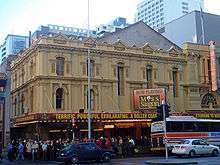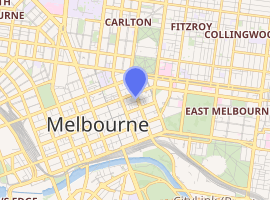Her Majesty's Theatre, Melbourne
Her Majesty's Theatre is a 1,700 seat theatre in Melbourne's East End Theatre District, Australia. Built in 1886, it is located at 219 Exhibition Street, Melbourne. It is classified by the National Trust of Australia and is listed on the Victorian Heritage Register.
Alexandra Theatre His Majesty's Theatre | |
 Her Majesty's Theatre, 2003 | |

| |
| Address | 219 Exhibition Street Melbourne Australia |
|---|---|
| Coordinates | |
| Owner | Mike Walsh, OBE |
| Designation | Victorian Heritage Register |
| Capacity | 1,700 |
| Current use | Musicals, opera |
| Construction | |
| Opened | 1886 |
| Architect | Nahum Barnet |
| Website | |
| www | |
Purchased in 2000 by Mike Walsh, the theatre was restored and refitted to accommodate larger productions.
History
The first recorded use of the area near the corner of Stephen (now known as Exhibition) Street and Little Bourke Street as a venue for entertainment was in 1880, when tiered seating was constructed and an openair venue for circuses and equestrian shows established.
The Hippodrome lasted four years before the French born entrepreneur, Jules François de Sales Joubert, secured a 30-year lease on the site and commissioned architect Nahum Barnet to design a theatre, business and accommodation complex.
In 1886, work on Joubert's project was completed. On 1 October, the Alexandra Theatre opened. Named after the then Princess of Wales, wife of the future King Edward VII, the theatre was the largest in the Southern Hemisphere, boasting a capacity of 2,800. The very first show staged was the comedy, Bad Lads. Also in the first year, the Australian classic, For the Term of His Natural Life, was performed, as was Saturday afternoon wrestling and a season of Italian opera.
The early days of the Alec (as it became known) were problematic. Joubert had spent almost twice his original budget on construction and had been unable to obtain the required operating licences for the hotel, bars and cafes of the complex. By November 1887, he was insolvent.
Early in 1888, the Australian born, internationally renowned actor and playwright, Alfred Dampier, leased the theatre and introduced a successful programming and pricing formula. The Alec prospered.
In 1900, well-known expatriate American theatrical producer, James Cassius Williamson, took over the lease of the theatre and engaged architect William Pitt to supervise renovations. The stage was lowered by 60 centimetres and the stalls and orchestra pit raised by almost 30 centimetres. The Dress Circle was remodelled and new boxes added. Seats were re-upholstered, re-painting carried out and a new stage curtain and new stage lighting installed. The theatre, re-vamped and re-christened Her Majesty's Theatre in honour of Queen Victoria, re-opened with a production of Gilbert and Sullivan’s HMS Pinafore on 19 May.
In 1909, after a private sound test, Dame Nellie Melba, by then an international star, declared that the theatre’s acoustics were "dead" and that she would not perform unless they were altered. Further renovations to the theatre's interior were carried out in time for Dame Nellie to hold her Australian opera debut in November 1911.
On 6 July 1913, J. C. Williamson – the biggest theatrical entrepreneur in the world at the time – died at the age of 68. As a mark of respect, all the Williamson theatres ‘were dark’ for one night, a rare tribute. The company he had established with Her Majesty's Theatre as its flagship however, continued to prosper, featuring the operettas of Gilbert and Sullivan as staple fare well into the 1920s.
The name change from the Alexandra to Her Majesty's Theatre occurred eight months before the death of Queen Victoria. The theatre management maintained the name despite there now being a King on the throne. In 1924, the theatre was renamed again as His Majesty's Theatre, this time in honour of King George V, after whose mother, the original theatre had been named.
Despite the changes in identity, the theatre consistently played host to the world's best artists and shows. The legendary Russian ballerina, Anna Pavlova, captivated Australian crowds at performances in 1926 and 1929.
Previous productions
Previous notable productions at Her Majesty's include:[1]
- 1953: Call Me Madam
- 1954: Paint Your Wagon
- 1955: Can-Can
- 1956: The Boy Friend
- 1957: The Pajama Game
- 1958: Damn Yankees
- 1959: My Fair Lady (Original Australian Production 1959)
- 1961: Oliver!
- 1962: Carnival
- 1963: Sail Away, How to Succeed in Business Without Really Trying
- 1964: Camelot, A Funny Thing Happened on the Way to the Forum
- 1965: Hello, Dolly!
- 1966: Funny Girl
- 1967: Sweet Charity, Fiddler on the Roof
- 1968: Mame
- 1969: I Do! I Do!, Fiddler on the Roof
- 1970: My Fair Lady, Promises, Promises, Man of La Mancha
- 1971: 1776, Charlie Girl
- 1972: No, No, Nanette
- 1973 Two Gentleman of Verona, Lloyd George Knew My Father, Godspell
- 1974: Pippin, A Little Night Music, Irene
- 1975: At Least You Can Say You've Seen It! (Barry Humphries), Gypsy
- 1976: The Wiz, Man of La Mancha, More Canterbury Tales
- 1977: The Twenties and All That Jazz, Harvey
- 1978: A Chorus Line, Isn't It Pathetic At His Age (Barry Humphries), Annie
- 1979: Sacred Cow (Reg Livermore), Hamlet (Old Vic Company)
- 1980: They're Playing Our Song, Up in One (Peter Allen), Son of Betty (Reg Livermore), 13 Rue de L'amour, Evita
- 1984: The Odd Couple
- 1986: Are You Lonesome Tonight?
- 1987: Sugar Babies, Cats
- 1989: Big River
- 1991: Buddy - The Buddy Holly Story
- 1993: Hot Shoe Shuffle, 42nd Street, Joseph and the Amazing Technicolor Dreamcoat
- 1994: A Chorus Line, The Pirates of Penzance
- 1995: The Mikado
- 1996: Smokey Joe's Cafe
- 1997: Sweet Charity
- 1998: An Ideal Husband, Chicago
- 2002: The Hollow Crown
- 2003: Cabaret, Hair, Nutcracker on Ice
- 2004: Eureka
- 2005: Mamma Mia!, Die Fledermaus (Melbourne Opera)
- 2006: An Inspector Calls, Così fan tutte (Victorian Opera),
- 2007: Madame Butterfly (Melbourne Opera), Miss Saigon, The Love of the Nightingale (Victorian Opera), Orphée et Eurydice (Victorian Opera), Monty Python's Spamalot
- 2008: Fiddler on the Roof, Billy Elliot the Musical
- 2009: Chicago
- 2010: Mamma Mia!, Mary Poppins
- 2011: Doctor Zhivago, QI Live
- 2012: A Chorus Line, Barry Humphries Farewell tour - Eat Pray Laugh!, A Funny Thing Happened on the way to The Forum
- 2013: Chitty Chitty Bang Bang, Hot Shoe Shuffle, The Graduate
- 2014: Grease, Bernadette Peters in Concert, Les Misérables
- 2015: Strictly Ballroom
- 2016: Georgy Girl - The Seekers Musical, Lucia di Lammermoor (Victorian Opera), Avenue Q, Singin' in the Rain, Kinky Boots
- 2017: Aladdin
- 2018: Beautiful: The Carole King Musical, The Rocky Horror Show, School of Rock
- 2019: Muriel's Wedding the Musical, Sweeney Todd, Charlie and the Chocolate Factory
- 2020: Shrek The Musical
References
- "AusStage - Her Majesty's Theatre". www.ausstage.edu.au. Retrieved 15 May 2017.